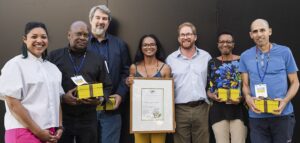A new online and video-based study by market research specialist Ipsos has revealed that South Africa’s R50-Billion Stokvel sector made up of more than 800 000 Stokvel groups and 11-million members* is a vast network of dynamic ‘human banks’ in the South African economy. This stems from the finding that despite the development of banking products aimed at these savings societies, cash remains the preferred mode of operation for most stokvels.
In addition, the Ipsos study highlights a persistent mistrust of traditional banking institutions, fuelled by perceptions of high fees, and bureaucratic red tape, such as lengthy account opening procedures, inflexible withdrawal restrictions, and hidden charges that erode savings.
Ipsos Client Officer Busisiwe Mahlaba says; “With an overall increase in stokvel membership and the creation of more diverse stokvels, members now have a greater array of choices regarding whom to partner with on their financial journeys and how to structure their administration systems to fit the group. Banks therefore need to address continued member resistance with simplified seamless experience that fosters trust and buy-in.” Mahlaba adds that the recognition of the enduring importance of cash also presents a strategic opportunity for the introduction of stokvel insurance. This emerging sector remains largely untapped, presenting a clear white space for exploration. For example, insights gleaned from burial societies featured prominently in the Ipos study, shedding light on how existing formal funeral insurance and burial policies often overlook this segment of the population.
Diversified goals & fresh faces
The Ipsos study also revealed a significant evolution in South Africa’s deeply rooted stokvel tradition that has expanded not only in terms of the types of stokvels but also the broader socio-economic and age range of their members. “Traditionally the domain of older members, stokvels increasingly attract younger generations and individuals across higher income brackets. These members are drawn to the wisdom and experience offered by their older counterparts,” Mahlaba elaborates. She adds that the inclusion of younger members is not only diversifying stokvels but also injecting fresh perspectives, technological expertise, and a desire for streamlined processes.
Alongside this demographic shift, the study also found that specialised stokvels are surging in popularity. These groups cater to specific needs such as weddings, investments, property purchases, and holidays. This adaptability highlights the collective ambition and financial aspirations driving stokvels’ evolution, often facilitated by the ease of communication and coordination offered by technology.
Innovation Nation
So, while a sense of community and tradition remain at the heart of the stokvel model, the integration of technology such as Whats App and Facebook is rapidly transforming how these groups operate. For example, social media platforms like WhatsApp have become central to communication, decision-making, and record keeping.
This shift reduces the need for frequent physical meetings and minimises the risks associated with handling large amounts of cash. Younger, more tech savvy members also appreciate the ease of electronic transfers further driving the evolution of stokvels.
In addition, the strong endorsement effect of community-driven Facebook pages which highlight the latest available promotions, are all effective tools that increase the ability of these fluid living breathing consumer entities to quickly adapt to changing market offerings and to leverage the opportunities they seek where, when and how they want often at a moment’s notice
Opportunity knocks
Turning to the close connection between grocery stokvels and the FMCG sector, the study found that in certain instances brands and retailers are already successfully collaborating with stokvels. In particular the strength of price-point specific coupons, bulk purchase options, and tailored digital promotions that support the collective savings approach of these groups.
Against this backdrop, Mahlaba says it’s clear that brands need to start breaking the codes and play cleverly in this space to ensure maximum impact and ROI. “To drive real interest and affiliation, they should aim to add value and enhance the established frameworks within stokvels, rather than revolutionising how these organised groups currently function.”
“They’re the human embodiment of South Africa’s unique spirit of Ubuntu and present vast opportunities for brands, especially within the FMCG sector, to connect and engage with this vibrant group of consumers,” she concludes.
*Source: National Stokvel Association of South Africa (https://nasasa.co.za/about-us/)
STUDY SOURCES:
- Video Ethnography – A core group of six respondents were the subject of in-depth video interviews that covered key topics around decision making, processes and events within stokvels
- Online Community – Ipsos created an Online community platform where members of various Stokvels shared their views and relationship to the category. Senior researchers moderated the community, which was open for 2 days, with n=100 respondents online







